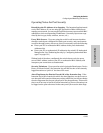
6-134
Configuring the Switch
Class of Service (CoS): Managing Bandwidth More Effectively
Configuring the Switch
Table 6-7. Priority Criteria and Precedence
Precedence Criteria Overview
1Device
Priority
(IP
Address)
You can specify a priority for any outbound packet having a particular destination or source IP
address. CoS allows up to 30 IP addresses. If an outbound packet has an IP address as the
destination, it takes precedence over another outbound packet that has the same IP address
as a source. (This can occur, for example, on an outbound port in a switch mesh environment.)
Default state: No IP address prioritization.
If a packet does not meet the criteria for device priority, then precedence defaults to IP Type of Service
(ToS) criteria, below.
2IP Type-
of-
Service
(ToS)
Applies only to IP packets. The ToS field in an IP packet is configured by an upstream device
or application before the incoming packet enters the switch, and is not altered by the switch.
CoS reads the packet’s Type of Service (ToS) field and prioritizes the packet (if specified in the
CoS configuration) for outbound transmission. For more on this topic, see “Using Type of
Service (ToS) Criteria To Prioritize IP Traffic” on 6-143. Default state: Disabled.
If a packet does not meet the criteria for ToS priority, then precedence defaults to Protocol criteria, below.
3Protocol
Priority
CoS can prioritize outbound packets for one or more of these network protocols: IP, IPX, ARP,
DEC LAT, AppleTalk, SNA, and NetBeui. Default state: No override for any protocol.
If a packet does not meet the criteria for Protocol priority, then precedence defaults to VLAN criteria, below.
4VLAN
Priority
Enables packet priority based on the name of the VLAN in which the packet exists. For example,
if the default VLAN (DEFAULT_VLAN) and the “Blue” VLAN are both assigned to a port, and
Blue VLAN traffic is more important, you can configure CoS to give Blue VLAN traffic a higher
priority than default VLAN traffic. (Priority is applied on the outbound port.) Default state: No
override.
If a packet does not meet the criteria for VLAN priority, then precedence defaults to Incoming 802.1p criteria,
below.
5 Incoming
802.1p
Priority
Where a packet enters the switch on a tagged VLAN, if CoS is not configured to apply to the
packet’s priority setting, the switch uses the packet’s existing 802.1p priority (assigned by an
upstream device or application) to determine which outbound port queue to use. If the packet
leaves the switch on a tagged VLAN, then there is no change to its 802.1p priority setting. If the
packet leaves the switch on an untagged VLAN, the 802.1p priority is dropped.
Entering
(Inbound) 802.1p
Priority
Outbound Port
Queue
Exiting
(Outbound)
802.1p Priority
0 - 3
4 - 7
Normal
High
0 - 3
4 - 7
If a packet does not meet the criteria for Incoming 802.1p priority, then the packet is sent to the “normal”
outbound queue of the appropriate port. If the packet did not enter the switch on a tagged VLAN, but exits
from the switch on a tagged VLAN, then a tagged VLAN field, including an 802.1p priority of 0 (normal), is
added to the packet.


















